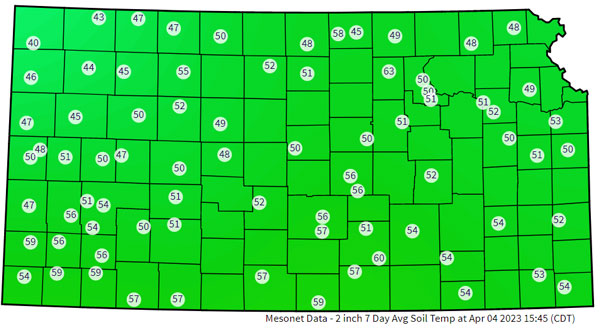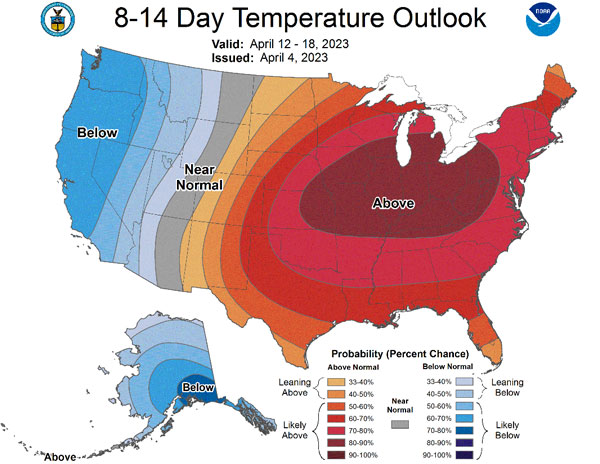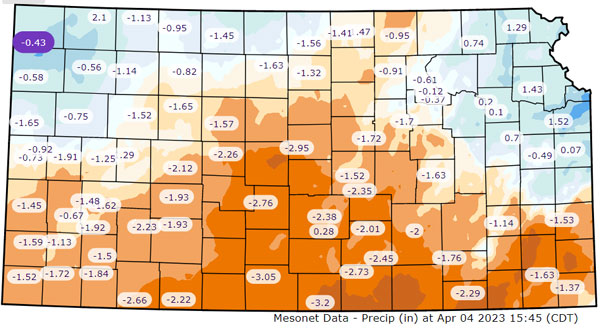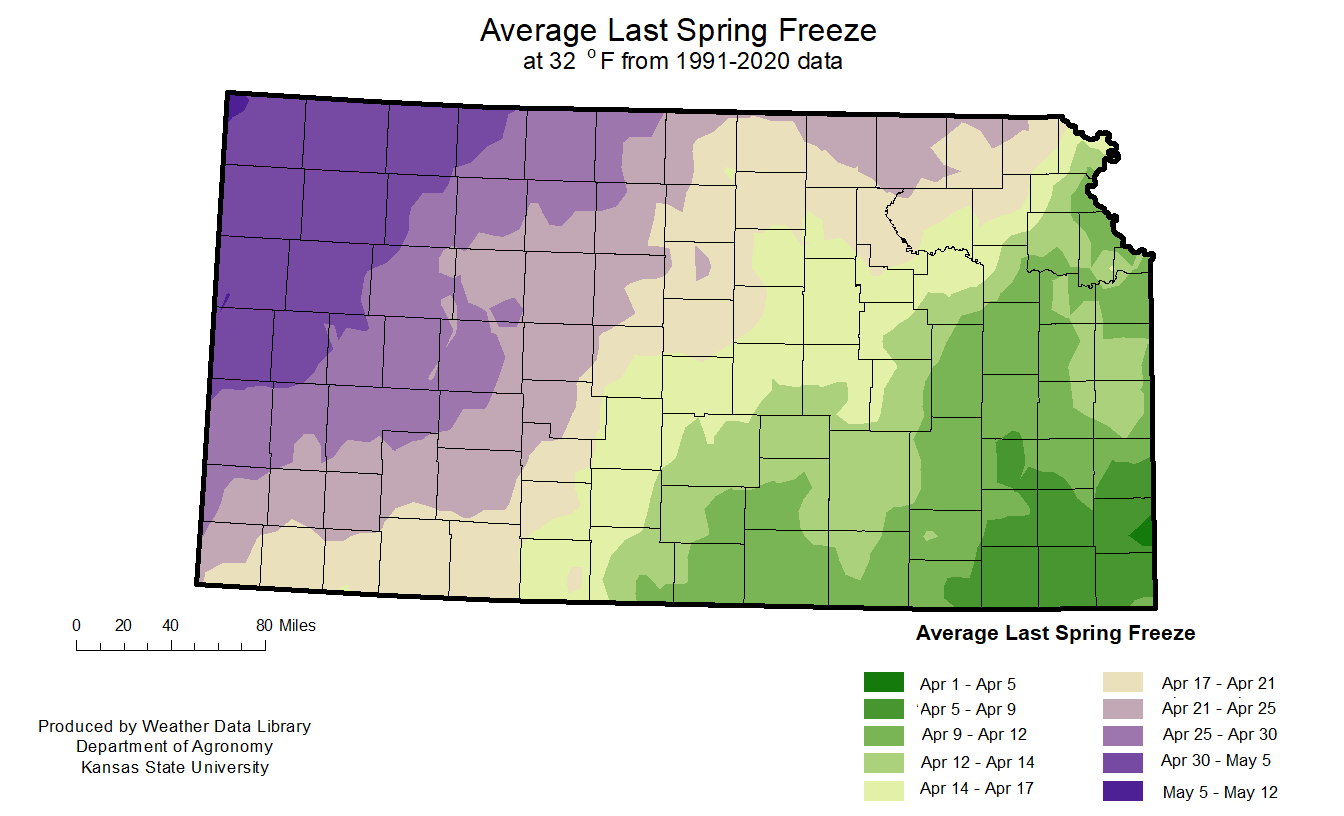Planting date is one of the most critical factors to decide on for row crops such as corn and soybean. Rather than just calendar dates, please consider basing this decision on soil temperature and moisture.
Soil temperature
After a below-normal March, April has started out warm. Many locations in eastern Kansas had their warmest day so far in 2023 on April 4. As a result, 7-day average soil temperatures, which were running well below normal, have warmed to near seasonal normal (Figure 1). Only the northwest is lagging behind, thanks to more snow in late March. Rawlins County had almost 8 inches of snow, while the Goodland area had another 5 inches, bringing their seasonal snow total to just over 40 inches. The 8 to 14-day temperature outlook (Figure 2) for the first half of April presents high probabilities of above-normal temperatures for the state, which should lead to an additional warming of soil temperatures.
You can monitor soil temperatures across the state by using the Kansas Mesonet’s soil temperature tracking tool at https://mesonet.k-state.edu/agriculture/soiltemp/.

Figure 1. Average soil temperatures at 2-inch soil depth for the week of March 29 to April 4, 2023. Source: Kansas Mesonet https://mesonet.k-state.edu/agriculture/soiltemp/
Precipitation and temperature outlooks
The 8 to 14-day precipitation outlook has slightly higher probabilities of above-normal precipitation statewide (Figure 3). Year-to-date totals are above normal in northeast and northwest Kansas (Figure 4) but much below normal across the south. Precipitation deficits during periods with little to no precipitation add up quickly during spring, so it is critical to have adequate precipitation in the spring months, especially given the precipitation deficits of last year.
It is worth mentioning that topsoil temperature differences could be large depending on multiple factors. Several factors will affect changes in any field, including soil type, soil moisture, residue cover, tillage, landscape position, and others. For example, wet soils under a no-tillage system are expected to warm up at a slower pace. Dry soils will fluctuate more rapidly, matching air temperatures, particularly if the skies are clear.

Figure 2. 8 to 14-day outlook temperature outlook for April 12-18, 2023. Source: NOAA.

Figure 3. 8 to 14-day outlook precipitation outlook for April 12-18, 2023. Source: NOAA.
Soil moisture
Current soil moisture status across Kansas indicates particularly dry conditions toward the southwest portion of the state, increasing to moderate or high saturation when moving to north central, northwest, and northeast regions, respectively (Figure 4).

Figure 4. Soil moisture at 2 inches (5 cm) as of April 5, 2023. Source: Kansas Mesonet https://mesonet.k-state.edu/agriculture/soilmoist/
The largest weekly departure in precipitation occurred in the southeast corner of Kansas (Figure 5). The precipitation outlook for this coming week is generally dry, with slightly elevated changes of above-normal precipitation the following week (Figure 3).

Figure 5. Departure from normal precipitation since January 1, 2023. Source: Kansas Mesonet.
Management considerations
Optimal soil temperature for crop emergence
Optimal soil temperatures for the emergence of row crops indicate a minimum of 50oF for appropriate corn germination and early growth. When soil temperatures remain at or below 50oF after planting, germination issues and severe seedling damage will be expected.
When soil temperatures are consistently above 55oF, uniformity and synchrony in emergence are expected. However, uneven soil temperatures around the seed zone (e.g. due to uneven sowing depth, moisture, and/or residue coverage) can produce non-uniform crop germination and emergence. These conditions could considerably impact corn potential yields due to uneven plant establishment in space and time. Competition between early-emerged and late-emerged plants and competition with weeds may negatively impact biomass and grain production. Compensation mechanisms like tillering have limited potential compared to other crop compensation mechanisms like branching in soybeans.
Hard freeze risks
Corn is also more likely than other summer crops to be affected by a hard freeze after emergence if it is planted too early. The impact of a hard freeze on emerged corn will vary depending on how low the temperature gets, the intensity and duration of the low temperatures, field variability, residue distribution, tillage systems, soil type, and moisture conditions (more severe under dry conditions), and the growth stage of the plant. Injury is most likely on very young seedlings or on plants beyond the V5-6 growth stage when the growing point is above the soil surface.
The average day for last spring freeze (32oF) is considerably variable across the state (Figure 6). From southeast to northwest Kansas; the earliest last spring freeze date is April 1-14 and the latest is May 5-12. Thus, corn planting dates before the second week of April in the southeast or the second week of May in the northwest would represent a high risk of suffering from late spring frost damage.

Figure 6. Average last spring freeze (32 degrees F) for Kansas. Source: Kansas Mesonet.
More information about the planting status of summer row crops will be provided in upcoming issues of the Agronomy eUpdate. Stay tuned!
Ignacio Ciampitti, Farming Systems
ciampitti@ksu.edu
Adrian Correndo, Post-doctoral Fellow
correndo@ksu.edu
Matthew Sittel, Assistant State Climatologist
msittel@ksu.edu
Christopher “Chip” Redmond, Kansas Mesonet Network Manager
christopherredomond@ksu.edu
Tags: soil moisture spring planting soil temperature planting date